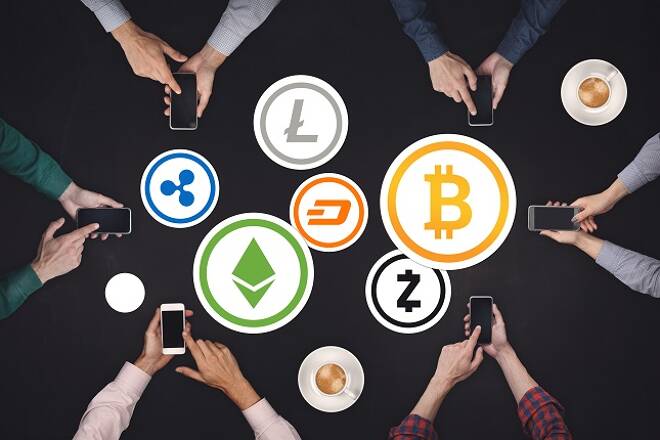Advertisement
Advertisement
The Crypto Menagerie: a Collection of the World’s Weirdest Altcoins
By:
Roll up, roll up, Ladies and Gentleman, for a spectacle unparalleled in its capacity to delight, astound and inspire – the infamous Crypto Menagerie, a peerless collection of the world’s strangest and most perplexing cryptocurrencies.
For one night only, FXTM Senior Writer Ben Lovell-Viggers plays ringmaster as he guides you through the bizarre world of altcoins. Expect chills, thrills and a litigious ‘half-man-half-fish hybrid’…
Dogecoin (DOGE)
Developed as a joke in 2013 by Billy Markus and Jackson Palmer, Dogecoin is immediately recognizable thanks to the furry countenance of its mascot, a Shinu Inu and bonafide internet legend called Kabosu. Unlike competing cryptocurrencies, there is no limit to how many Dogecoin can be produced. This means that Dogecoin is unlikely to appreciate in value to the same extent as its peers; however, the currency has seen success as an online tipping system, used to reward notable content on sites like Reddit. Combined with high-profile charitable endeavors like sending the Jamaican Bobsled Team to the Sochi Winter Olympics, and you’ve got all the ingredients for a cult-status cryptocurrency. Very wow! Much excite!
Unobtanium (UNO)
Unobtanium markets itself as ‘the platinum to Bitcoin’s gold’, ‘something to acquire and hold over a long period of time, similar to precious metals’. The precious metal allegory doesn’t stop there – quantities of Uno are measured in ‘kgs’. Only 250,000 Uno have been made available for mining over the next 300 years, making them rare – really rare. Despite this, Uno’s popularity endures while hundreds of altcoins have bitten the dust. A collector’s novelty or a genuine cryptocurrency? You decide.
Petro
One of the few cryptocurrencies on this list that isn’t a joke – at least, not a funny one. Venezuelan President Nicolás Maduro revealed the ‘petromoneda’ cryptocurrency in December as a means to “advance monetary sovereignty” and open up “new forms of international financing”. Ostensibly backed by Venezuela’s oil, gold and diamond reserves, the petro has been greeted with near-universal skepticism. Its announcement comes against a backdrop of civil disorder, severe shortages of basic necessities and double-digit inflation; critics have warned that further hyperinflation of Venezuela’s currency, the bolivar, is the most likely result. Some experts argue that the petro is little more than an elaborate money-laundering scheme, used by the wealthy and powerful to smuggle funds out of Venezuela’s imploding economy.
TrumpCoin (TRUMP)
As someone who surfed a cresting wave of internet memes all the way to the US Presidency, it should come as no surprise whatsoever that Donald Trump has a digital currency named for him. In its own words, TrumpCoin’s ultimate goal is to ‘support President Trump and his powerful vision to Make America Great Again’. Having seen The Donald successfully installed in the Whitehouse, the ‘Trump Patriots’ behind TrumpCoin pledge that their crypto ‘will continue to integrate itself into the agenda of President Trump’.
200,000 of the six million available TrumpCoins have been set aside for donation to the Trump administration once the currency reaches ‘a substantial value’ – because even billionaire statesmen could always use a little cash injection.
PutinCoin (PUT)
We couldn’t include TrumpCoin on this list without mentioning its spiritual counterpart: the PutinCoin, named for the enigmatic Russian premier. PutinCoin’s creators don’t beat about the bush – in their words, this crypto was created to ‘pay tribute to the people and the president of one of the largest and greatest countries in the world: Russia (sic)!’ In fact, PutinCoin is only one of several cryptocurrencies that celebrate Vladimir Vladimirovich Putin. PutinClassic (PUTIC) is one notable example, despite operating more as a digital ‘souvenir’ than a functional cryptocurrency. ‘It is nice to keep in your wallet’, insists the PutinClassic official forum.
Useless Ethereum Token (UET)
UET markets itself as ‘the world’s first 100% honest Ethereum ICO’. And honest it most definitely is:
‘You’re going to give some random person on the internet money, and they’re going to take it and go buy stuff with it. Probably electronics, to be honest. Maybe even a big-screen television. Seriously, don’t buy these tokens.’
Need we say more?
Mooncoin (MOON)
Like many successful cryptocurrencies, Mooncoin has a frivolous gimmick – it limits its total coin supply based on the average distance of the Earth from the Moon. That, however, is where the frivolity ends. Created with a focus on ease-of-use and transparency, this increasingly-popular crypto is designed for micropayments. Low transaction costs and block time, combined with a large coin supply, make mining Mooncoin significantly easier than other digital currencies. And that’s not all – the creators of Mooncoin are also responsible for developing MoonWord, a free programming language, and SmartLikes, a way of monetizing ‘likes’ on online content using Mooncoin. Fun fact: there’s a town called Mooncoin in County Kilkenny, Ireland.
Coinye (COINYE)
Famous for its short life as much as its libelous premise, Coinye lived fast and died young. Released on January 7th, 2014 as ‘Coinye West’, this script-based cryptocurrency featured famously-lighthearted rapper Kanye West as its mascot – without his permission. A trademark infringement lawsuit swiftly followed. Even changing the name to ‘Coinye’ and replacing West’s likeness with that of a ‘half-man-half-fish hybrid’ could not delay the inevitable, and by January 14th – a mere week after release – Coinye was no more. “I’ve never had someone try and sue me before, let alone an A-list celebrity,” Coinye developer Harry Willis recounted. “We didn’t win, but we’ve cost Mr. West thousands in legal fees which is a great feeling.”
For the latest market news, visit FXTM.
About the Author
Lukman Otunugaauthor
Lukman Otunuga is a research analyst at FXTM. A keen follower of macroeconomic events, with a strong professional and academic background in finance, Lukman is well versed in the various factors affecting the currency and commodity markets.
Did you find this article useful?
Latest news and analysis
Advertisement
